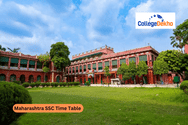TN 10th Syllabus 2025-26 includes two language papers followed by three mains. The theory paper for Mathematics and Social Science will be conducted for 100 marks. The Science paper will be conducted for 75 marks.


Never Miss an Exam Update
TN 10th Syllabus 2025-26 helps in learning about the units and sub-topics included in each subject of the curriculum. The Tamil Nadu SSLC curriculum consists of two language papers followed by three main subjects. You can choose two languages from Tamil, Telugu, Kannada, Gujarati, Arabic, French, English, Hindi, Sanskrit, etc. Apart from these languages, there will be Mathematics, Social Science, and Science as main subjects. The languages paper, along with Mathematics and Social Science, will be conducted for 100 marks. The theory paper for Science will be conducted for 75 marks. Do not forget to download the Tamil Nadu SSLC Exam Pattern 2025-26 to check the question paper pattern.
Want to download the TN 10th Syllabus 2025-26? Read below:
Latest Updates
- Nov 4, 2025: The Directorate of Government Examination (DGE) TN released TN 10th date sheet 2026 today November 4, 2025. TN SSLC exam 2026 will be held from March 11, 2026 to April 6, 2026.
TN 10th Syllabus 2025-26 PDF Download
You can refer to the TN 10th Syllabus PDF given in the table below to enhance your preparation for the exams and learn about the units included in each subject:
| Subjects | Syllabus (English medium) |
|---|---|
Mathematics | Download here |
Social Science | Download here |
Science | Download here |
| Download here | |
| Tamil | Download here |
Tamil Nadu 10th Mathematics Syllabus 2025-26
Tamil Nadu Class 10 Math Syllabus 2025-26 is divided into eight main chapters. To secure at least 35% marks, you should carefully study and understand each topic in the syllabus. Check the syllabus given in the table below.
Topics | Sub-topics |
|---|---|
Relations and functions | Ordered Pair, Cartesian product, Relations |
Numbers and Sequences | Euclid’s Division Lemma and Algorithm, Fundamental Theorem of Arithmetic, Sequences, Arithmetic Progression |
Algebra | Simultaneous Linear Equations in three variables, GCD and LCM of Polynomials, Rational expressions, Square Root of Polynomials, Quadratic Equations and Graph, etc. |
Geometry | Similarity, Thales Theorem and Angle Bisector Theorem, Pythagoras Theorem, Circles and Tangents, Concurrency Theorems |
Coordinate Geometry | Area of a Triangle, Area of a Quadrilateral, Inclination of a Line, Straight Line, General Form of a Straight Line |
Trigonometry | Trigonometric Identities, Heights and Distances |
Mensuration | Surface Area, Volume, Volume and Surface Area of Combined Solids with no change in Volume |
Statistics and Probability | Algebra of Events, Probability |
TN 10th Social Science Syllabus 2025-26
You can refer to the detailed Tamil Nadu Class 10 Social Science Syllabus 2025-26 below:
History-
- The outbreak of World War I and Its Aftermath
- The World Between Two World Wars
- World War II
- The World after World War II
- Social and Religious Reform Movements in the 19th Century
Geography-
- India - Location, Relief, and Drainage
- Climate and Natural Vegetation of India
- Components of Agriculture
- Resources and Industries
- India - Population, Transport, Communication and Trade
Civics-
- Indian Constitution
- Central Government
- State Government
Economics-
- Gross Domestic Product and Its Growth
- Globalization and Trade
Tamil Nadu 10th Science Syllabus 2025-26
Tamil Nadu Class 10 Science Syllabus 2025-26 is extensive, so make sure to prepare it from the very beginning of the academic year. Check out the detailed syllabus from the table given below:
Units | Topics |
|---|---|
Laws of Motion | Introduction 1.1 Force and Motion 1.2 Inertia 1.2.1 Types of Inertia 1.2.2 Examples of Inertia 1.3 Linear Momentum 1.4 Newton’s Laws of Motion 1.4.1 Newton’s First Law 1.4.2 Force 1.4.3 Types of forces 1.4.4 Resultant Force 1.5 Newton’s Second Law of Motion 1.7 Newton’s Third Law of Motion 1.9 Rocket propulsion 1.10 Gravitation 1.10.1 Newton’s Universal law of gravitation 1.11 Mass and Weight |
Optics | Introduction 2.1 Properties of light 2.2 Refraction of Light 2.2.1 First Law of Refraction 2.2.2 Second Law of Refraction 2.3 Refraction of composite Light - Dispersion of Light 2.5 Lenses 2.5.1 Other Types of Lenses 2.6 Images formed due to refraction through a convex and concave lens 2.7. Refraction through a convex lens 2.8 Applications of a Convex lens 2.9 Refraction through a concave lens 2.10 Applications of concave lenses 2.11 Lens Formula 2.12 Sign Convention 2.16 Human eye 2.17 Defects in eye |
Thermal Physics | Introduction 3.1 Temperature 3.1.1 Absolute scale (Kelvin scale) of temperature 3.1.2 Thermal equilibrium 3.2 Thermal Energy 3.2.1 Characteristic features of heat energy transfer 3.2.2 Other units of Heat energy 3.4 Fundamental laws of gases 3.4.1 Boyle’s law 3.4.2 Charles’ law 3.4.3 Avogadro’s law 3.5 Gases 3.5.1 Real gases 3.5.2 Ideal gases |
Electricity | Introduction 4.1 Electric Current 4.1.1 Definition of Electric Current 4.1.2 SI unit of Electric current 4.2 Electric circuit 4.2.1 Electrical components 4.3 Electric potential and Potential difference 4.3.1 Electric Potential 4.3.2 Electric Potential Difference 4.3.3 Volt 4.4 Ohm’s law 4.5 Resistance of a material 4.5.1 Unit of Resistance 4.6 Electrical resistivity and electrical conductivity 4.6.1 Electrical resistivity 4.6.2 Conductance and Conductivity 4.8 Heating effect of current 4.8.1 Joule’s Law of Heating 4.9 Electric power 4.9.1 Unit of electric power 4.9.2 Consumption of electrical energy |
Acoustics | Introduction 5.1 Sound waves 5.1.1 Longitudinal Waves 5.1.2 Categories of Sound waves based on their frequencies 5.1.3 Difference between the sound and light waves 5.2 Reflection of sound 5.2.1 Laws of reflection 5.2.2 Reflection at the boundary of a denser medium 5.2.3 Reflection at the boundary of a rarer medium 5.2.4 Reflection of sound in plane and curved surfaces 5.3 Echoes 5.3.1 Conditions necessary for hearing echo 5.3.2 Applications of echo |
Nuclear Physics | Introduction 6.1. Radioactivity 6.1.1 Discovery of radioactivity 6.1.2 Definition of radioactivity 6.1.3 Natural Radioactivity 6.1.4 Artificial Radioactivity (or) Induced Radioactivity 6.1.5 Units of Radioactivity 6.2. Alpha, beta and gamma rays 6.2.1 Properties of Alpha, Beta and Gamma rays 6.2.2 Radioactive displacement law 6.2.3 Alpha decay 6.2.4 Beta decay 6.2.5 Gamma decay 6.5. Uses of Radioactivity 6.5.1 Agriculture 6.5.2 Medicine 6.5.3 Industries 6.5.4 Archaeological Research 6.6. Safety measures 6.6.1 Permitted range 6.6.2 Preventive Measures |
Atoms and molecules | Introduction 7.1 Atom and Atomic mass 7.1.1 Relative Atomic mass (REM) 7.2 Molecule and molecular mass 7.2.1 Classification of molecules 7.3 Difference between atoms and molecules 7.6 Avogadro hypothesis 7.7. Applications of Avogadro’s Law 7.9 Solved problems (Problems related to the above-mentioned topics only) |
Periodic classification of elements | Introduction 8.1 Modern periodic law 8.2 Modern periodic table 8.2.1 Features of periods 8.2.2 Features of groups 8.6. Properties of metals 8.6.1 Physical properties 8.6.2 Chemical properties 8.10 Alloys 8.10.1 Amalgam 8.10.2 Method of making alloys 8.10.3 Types of alloys 8.11 Corrosion 8.11.2 Methods of preventing corrosion |
Solutions | Introduction 9.2 Components of solutions 9.3 Types of solutions 9.3.1 Based on the physical state of the solute and the solvent 9.3.2 Based on the type of solvent 9.3.3 Based on the amount of solute 9.3.4 Concentrated and dilute Solutions 9.6 Hydrated salts and water of crystallization 9.6.1 Copper sulphate pentahydrate 9.6.2 Magnesium sulphate heptahydrate 9.7 Hygroscopy 9.8 Deliquescence |
Types of chemical reactions | Introduction 10.1 Types of Chemical reactions 10.1.1 Classification based on the nature of rearrangements of atoms 10.1.2 Classification based on the direction of reaction 10.4 Ionic product of water 10.5 pH scale 10.7 pH calculations 10.8 Problems |
Carbon and its compounds | Introduction 11.1 General characteristics of organic compounds 11.2 Classification of organic compounds based on the pattern of carbon chain 11.3 Classes of organic compounds (Based on the kind of atoms 11.3.1 Hydrocarbons 11.3.2 Characteristics of hydrocarbons 11.3.3 Classification of organic compounds based on functional groups 11.4 Homologous series 11.4.1 Characteristics of homologous series 11.5 Nomenclature of organic compounds 11.5.1 Why do we need nomenclature? 11.5.2 Components of an IUPAC name 11.5.3 IUPAC rules for naming organic compounds 11.5.4 IUPAC nomenclature of hydrocarbons – Solved Examples 11.5.5 IUPAC nomenclature of other classes – Solved Examples 11.6 Ethanol 11.6.1 Manufacture of ethanol 11.6.2 Physical properties 11.6.3 Chemical properties 11.6.4 Uses of ethanol 11.8 Organic compounds in daily life |
Plant Anatomy and Plant Physiology | Introduction 12.1 Tissues 12.2 Tissue system 12.2.1 Dermal or Epidermal tissue system 12.2.2 Ground tissue system 12.2.3 Vascular tissue system 12.3 Internal structure of dicot root (Bean) 12.5 Internal structure of dicot Stem (Sunflower) 12.7 Internal structure of dicot or dorsi-ventral leaf (Mango) 12.9 Plant Physiology 12.9.1 Plastids 12.9.2 Structure of chloroplast 12.9.3 Functions of chloroplast 12.9.4 Photosynthesis 12.9.5 Where does photosynthesis occur? 12.9.6 Photosynthetic pigments 12.9.7 Role of sunlight in photosynthesis 12.9.8 Factors affecting photosynthesis 12.11 Types of respiration 12.11.1 Aerobic respiration (Except Stages) 12.11.2 Anaerobic respiration 12.11.3 Respiratory quotient |
Transportation in Plants and Circulation in Animals | Introduction 14.1 Means of Transport in Plants 14.1.1 Diffusion 14.1.2 Active Transport 14.1.3 Osmosis 14.2 Root hair – water absorbing unit 14.3 Pathway of water absorbed by roots 14.4 Types of movement of water into the root cells 14.4.1 Apoplast Pathway 14.4.2 Symplast Pathway 14.5 Transpiration 14.5.1 Factors affecting transpiration, 14.6 Root pressure 14.7 Uptake of minerals 14.8 Translocation of Mineral Ions 14.9 Phloem Transport 14.10 Translocation of sugars 14.12 Blood 14.15 Structure of the Human Heart 14.15.2 Heartbeat 14.17 Blood Groups |
Plant and animal hormones | Introduction 16.1 Plant Hormones 16.1.1 Auxins (Except Went’s Experiment) 16.1.2 Cytokinins 16.1.3 Gibberellins 16.2 Human Endocrine glands 16.2.1 Pituitary Gland 16.2.2 Thyroid Gland 16.2.4 Pancreas (Islets of Langerhans) 16.2.5 Adrenal Gland 16.2.6 Reproductive Glands 16.2.7 Thymus Gland |
Reproduction in plants and animals | Introduction 17.3 Sexual Reproduction in Plants 17.3.1 Parts of a Typical Flower 17.3.2 Structure of the Ovule 17.4 Pollination 17.4.1 Types of Pollination 17.6 Fertilization in Plants 17.7 Sexual reproduction in humans 17.7.1 Male reproductive organ - Structure of Testes 17.7.2. Female reproductive organ - Structure of Ovary 17.8 Gametogenesis 17.8.1 Structure of human Sperm 17.8.2 Structure of human Ovum 17.9 Menstrual cycle - Process of Ovulation 17.14 Personal Hygiene 17.14.1 Body Hygiene 17.14.2 Toilet Hygiene 17.14.3 Menstrual and napkin Hygiene |
Genetics | Introduction 18.1 Gregor Johann Mendel – Father of Genetics 18.2 Monohybrid cross-Inheritance of one gene 18.3 Dihybrid Cross- Inheritance of two genes and Law of Independent Assortment 18.4 Mendel’s laws 18.5 Chromosomes, DNA and genes 18.5.1 Structure of a Chromosome 18.5.4. Karyotype 18.6 Structure of DNA 18.6.1 Watson and Crick model of DNA 18.6.2 DNA Replication 18.6.3 Significance of DNA 18.7. Sex Determination 18.7.1. Sex Determination in Human |
Origin and Evolution of Life | Introduction 19.1 Theories on origin of life 19.3 Theories of Evolution 19.3.1 Lamarckism 19.3.2 Darvinism or Theory of natural selection 19.6 Ethnobotany |
Breeding and Biotechnology | Introduction 20.2 Green Revolution 20.2.4 Plant breeding for improved nutritional quality 20.3 Methods of Plant Breeding for Crop Improvement 20.3.1 Introduction of new varieties of plants 20.3.2 Selection 20.3.3 Polyploidy Breeding 20.3.4 Mutation Breeding 20.3.5 Hybradisation 20.4 Animal Breeding 20.4.1 Inbreeding 20.4.2 Outbreeding 20.4.3 Heterosis 20.6 Biotechnology in Medicine |
Health and Diseases | Introduction 21.1 Abuse and types of abuse 21.1.1 Child Abuse 21.1.2 Sexual Abuse 21.1.3 Child Sexual Abuse 21.1.4 Approaches for protection of an abused child 21.2 Drug and tobacco abuse 21.3 Drug abuse 21.3.1 Types of Drug 21.3.2 Drug dependence 21.3.3 Behavioural changes of drug users 21.3.4 Drug De-addiction 21.4 Tobacco abuse 21.4.1 Tobacco Use 21.4.2 Smoking Hazards and effects of Tobacco 21.4.3 Prevention of smoking 21.5 Alcohol abuse 21.5.1 Harmful effects of alcohol to health 21.6 Rehabilitation measures for alcoholics 21.9 Obesity 21.9.1 Prevention and control of obesity 21.11 Cancer 21.11.1 Types of Cancer 21.11.2 Carcinogenic agents 21.11.3 Treatment of Cancer 21.11.4 Preventive measures for cancer 21.12 AIDS 21.12.1 Transmission of HIV 21.12.2 Symptoms and treatment of AIDS 21.12.3 Prevention and control of AIDS |
Environmental management | Introduction 22.1 Conservation and judicious use of Resources 22.5 Renewable and non- renewable Energy Resources 22.5.1 Fossil Fuels 22.5.2 Coal and Petroleum 22.5.3 Steps to conserve coal and petroleum resources 22.6 Non-Conventional (Alternative) Energy Resources 22.6.3 Shale gas 22.6.5 Water energy 22.6.6 Tidal energy 22.7 Rainwater Harvesting 22.8. Electrical Energy Management 22.9 E-Waste and its management |
Tamil Nadu 10th English Syllabus 2025-26
There are 5 sections in the English paper. The topics to be studied for these sections are given below:
Prose-
- His First Flight
- Empowered Women Navigating the World
- The Attic
- Tech Bloomers
- The Last Lesson
Poem-
- Life
- I am every woman
- The Secret of the Machines
Supplementary-
- The Tempest
- Zigzag
Grammar-
- Modals, Active & Passive Voice, Articles, Prepositions, Tense, Phrases and Clauses, Conjunctions, Pronouns, Reported speech, Subject-Verb Agreement, Non-Finites, Simple, Complex, and Compound
TN 10th Hindi Syllabus 2025-26
Hindi is one of the language paper. Check the TN 10th Hindi Syllabus 2025-26 below:
| Sections | Topic Covered |
| Prose | कबीर – साखी (Kabir – Sakhi), मैथिलीशरण गुप्त – मानुषीता (Maithilisharan Gupta – Manushita), मीरा – पद (Meera – Pad) |
| Grammar | संधि (Sandhi), समास (Samas), वाक्य रचना (Sentence Structure), काल (Tenses), वाच्य (Voice) |
| Poetry | सुमित्रानंदन पंत – परवत प्रदेश के पावस (Sumitranandan Pant – Parvat Pradesh Ke Pavas) |
| Writing | निबंध लेखन (Essay Writing), संवाद लेखन (Dialogue Writing), पत्र लेखन (Letter Writing), कहानी लेखन (Story Writing) |
You must download the latest Tamil Nadu 10th Syllabus 2025-26 by visiting the official website of DGE Tamil Nadu. Make sure to refer to the latest curriculum to avoid making any mistakes when preparing for the exams or planning out your study sessions.
Are you feeling lost and unsure about what career path to take after completing 12th standard?
Say goodbye to confusion and hello to a bright future!

FAQs
TN 10th Syllabus 2025-26 has yet to be released by the TN Board. It is anticipated to be released soon. The board does not significantly alter the syllabus each year. However, we will update the syllabus on this website if there are any changes.
TN 10th Syllabus 2025-26 covers a wide range of topics, hence it is not possible to finish the syllabus in just one month.
The Directorate of Government Examination, Tamil Nadu, will publish the TN 10th Syllabus 2025-26 . You can download the syllabus from the official website of the board authorities.
To get the TN 10th Syllabus 2025-26, go to the Directorate of Government Examinations' official website @ dge.tn.gov.in. The direct link to download the syllabus will be mentioned there.
The subjects included in the TN 10th Syllabus 2025-26 are Tamil, Hindi, English, Mathematics, Science, Social Studies, Environmental Sciences (EVS), etc.
Was this article helpful?



















